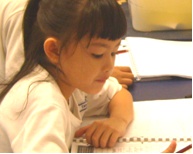Give our Children the Skills for Learning
 In a typical school environment, we often determine a child’s academic potential and achievement based on whether he can complete the assignments given, the quality of the answers given in class and the marks he managed to score for his examinations (this is often the one most important determinant teachers and parents use to assess the ‘potential’ of a child).
In a typical school environment, we often determine a child’s academic potential and achievement based on whether he can complete the assignments given, the quality of the answers given in class and the marks he managed to score for his examinations (this is often the one most important determinant teachers and parents use to assess the ‘potential’ of a child).
However, this perspective of analysing a child’s potential to learn prevents us from truly understanding what a child is capable of. We are merely seeing and judging the child’s ability from a final grade or marks scored for a particular subject.
And precisely because many of us perceive learning as the ability to produce content output, we tend to also believe that if a child does not score well or has not improved, we then need to repeat and re-teach the content again (and again) to ensure that it has been learnt. (Therefore, if a child is not good at solving problem sums or bad at answering comprehension questions, we try to ‘improve the problem’ by providing more opportunities for practice and repetition)
But, it is necessary to understand and see learning as two distinct parts when we are assessing a child’s learning ability and potential:
Using a simple task such as ‘Spelling’, it is easy to see the difference between the two parts to learning:
Part 1: Specific academic subjects learning
Spelling in itself is a specific learning output task, where we are testing to see if a child can replicate an accurate impression of given words by writing it out. (and we determine their proficiency by scoring the words that are spelled correctly)
Part 2: Underlying ability to perform
To be good at spelling or to improve spelling ability, we need to analyse and understand the skills needed to do it, which are as follows:
From the analysis of a ‘simple’ task as above, we can see that spelling is not as simple as just remembering a few words. And when a child spells poorly, he may not necessarily benefit and improve from more corrections and more repetition, but rather, we need to first understand the level of his underlying abilities to perform the task (or the reasons behind his difficulties or under-performance)
When we approach learning achievement from the bottom-up, meaning that we first understand a child’s ability to learn and then proceed to equip him with stronger abilities for learning, then we can truly expect the fulfilment of a child’s true learning potential and ignite a real love and joy for learning.
To find out more about your child’s underlying ability to learn, register for our Complimentary Learning Assessment. – Understanding your child’s profile is the first step to helping him/her learn better.
Article contributed by ThinkersBox.
